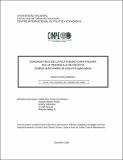| dc.contributor.author | Hartley Ballestero, Marjorie | |
| dc.date.accessioned | 2014-05-07T22:50:21Z | |
| dc.date.available | 2014-05-07T22:50:21Z | |
| dc.date.issued | 2008-12 | |
| dc.identifier.uri | http://hdl.handle.net/11056/8627 | |
| dc.description.abstract | Como parte de las primeras tareas para el desarrollo del proyecto "Effective Adaptation Strategies and Risk Redution towards Economica and Climatic Shocks: Lessons from the Coffee Crisis in Mesoamerica", se planteó la necesidad de contar con un diagnóstico preliminar que permitiera mostrar el estado actual y las perspectivas futuras de la actividad cafetalera, en las dos áreas de estudio elegidas para Costa Rica: León Cortés y la Península de Nicoya. Este estudio presenta los resultados para esta última región, ordenando la descripción bajo en enfoque de Cadenas Globales de Mercancías (CGM). Por tanto, se enfatiza en identificar la estructura de la cadena, los canales de comercialización y se describen los agentes participantes en cada segmento. Se hace un esfuerzo además por identificar las estrategias seguidas por los productores para enfrentar las sucesivas crisis de precios internacionales, ataque de plagas y enfermedades, fenómenos naturales. Existen en la región, algunas experiencias de pequeños productores que han recurrido a estrategias e innovaciones que les han permitido mantener y en algunos casos mejorar, sus condiciones de vida, sin abandonar la producción del café. | es_ES |
| dc.description.abstract | As part of the activities of the project: "Effective Adaptation Strategies and Risk Redution towards Economica and Climatic Shocks: Lessons from the Coffee Crisis in Mesoamerica", a diagnosis was required in order to show the current state and future perspectives of the coffee activity, in the two areas selected for the case studies in Costa Rica: León Cortés y la Península de Nicoya. The present document presents the results of the diagnosis for the Península de Nicoya region, where the description is made by using the Global Commodity Chain approach (GCC). The study identifies the structure of the chain, the channels of commercialization and the description of the participant agents in each segment of the coffee chain. Of key importance is the identification of the strategies followed by the agricultural producers in order to face the successive crisis of international prices, attack of plagues and natural phenomenon. In this region, some experiences have shown how small scale producers have applied strategies and innovations that have allowed them to maintain and in some cases improve their quality of life, without abandoning the production of the coffee. | en_US |
| dc.description.sponsorship | Inter American Institute for Global Change | es_ES |
| dc.format | application/pdf | |
| dc.language.iso | es | es_ES |
| dc.publisher | Centro Internacional de Política Económica para el Desarrollo Sostenible (CINPE) | es_ES |
| dc.relation.ispartofseries | 001-2009 | |
| dc.rights | Atribución-NoComercial-SinDerivadas 3.0 Costa Rica | es_ES |
| dc.rights.uri | http://creativecommons.org/licenses/by-nc-nd/3.0/cr/ | * |
| dc.title | Diagnóstico de la actividad cafetalera en la Península de Nicoya: análisis de los medios de vida en la agrocadena. (SDT 001-2009) | es_ES |
| dc.type | http://purl.org/coar/resource_type/c_93fc | |
| bk-old-una.tipo | Serie | |


